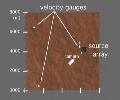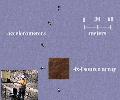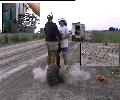 Figure 1:
Near-regional instrumentation plan illustrating the
utilization of
velocity transducers and cameras to document explosion processes.
Figure 1:
Near-regional instrumentation plan illustrating the
utilization of
velocity transducers and cameras to document explosion processes.
II. EXPERIMENTAL DESIGN
Quantifying mining blasts in terms of their characteristics and importance as sources of regional seismic signals is the goal of this study. Experimental design is constrained by this goal and requires a combination of near-source and regional observations of different types in order to make an unambiguous assessment of source processes and their importance to the regional signal. The components of the experiment are described in this section.
 Figure 1:
Near-regional instrumentation plan illustrating the
utilization of
velocity transducers and cameras to document explosion processes.
Figure 1:
Near-regional instrumentation plan illustrating the
utilization of
velocity transducers and cameras to document explosion processes.
Regional signals from the sources are the data that will be interpreted under an operative CTBT so these seismic signals become the foundation of the experiments. Propagation paths to regional stations at hundreds to thousands of kilometers can be quite complex and thus it is not always possible to unambiguously separate source from propagation effects. In order to facilitate this separation, these experiments have both near-regional and near-source instrumentation to document the generation and propagation of the seismic energy. Figure 1 illustrates the near-regional instrumentation component. Velocity transducers with digital event recorders and satellite (GPS or GOES) clocks are deployed to quantify the transition of the wavefield from what is labeled as the source array out to tens of kilometers.
 Figure 2:
Near-source instrumentation plan illustrating the installation of one
of the accelerometers and accompanying data acquisition units. The source
in this case is a 4x4 array of cylindrical boreholes detonated sequentially.
Figure 2:
Near-source instrumentation plan illustrating the installation of one
of the accelerometers and accompanying data acquisition units. The source
in this case is a 4x4 array of cylindrical boreholes detonated sequentially.
Accelerometers are installed at distances of tens of meters in order to provide a broad band characterization of the source processes (in this specific case four rows each with four cylindrical boreholes filled with explosives) at a distance with a minimum of contamination from propagation path effects (Figure 2). In addition to the seismic instrumentation, it has been found useful to deploy both Hi-8 video and high speed film cameras to document blasting practices, in particular timing of individual explosions and resulting mass movement.
 Figure 3:
Test bed refraction survey with the P wave source. Upper left insert
illustrates the data acquisition unit while the lower right insert focuses on
vertical and horizontal geophones used to measure ground motions.
Figure 3:
Test bed refraction survey with the P wave source. Upper left insert
illustrates the data acquisition unit while the lower right insert focuses on
vertical and horizontal geophones used to measure ground motions.
Critical to quantifying the coupling of explosively generated energy into the ground and its propagation is an understanding of the near-source material properties. An important part of this material property determination is the completion of P and S refraction/reflection surveys of the test bed as indicated in Figure 3. Exploration sources for both P and S waves are used to impart energy into the near surface materials where the explosive will be detonated. Geophones are placed at close intervals to determine the velocities of the near surface materials and in some instances the dispersion of shallow surface waves. In addition to the seismic instrumentation, the three dimensional characteristics of the test bed and source locations are surveyed.
Go to
Table of Contents
or
Next Section